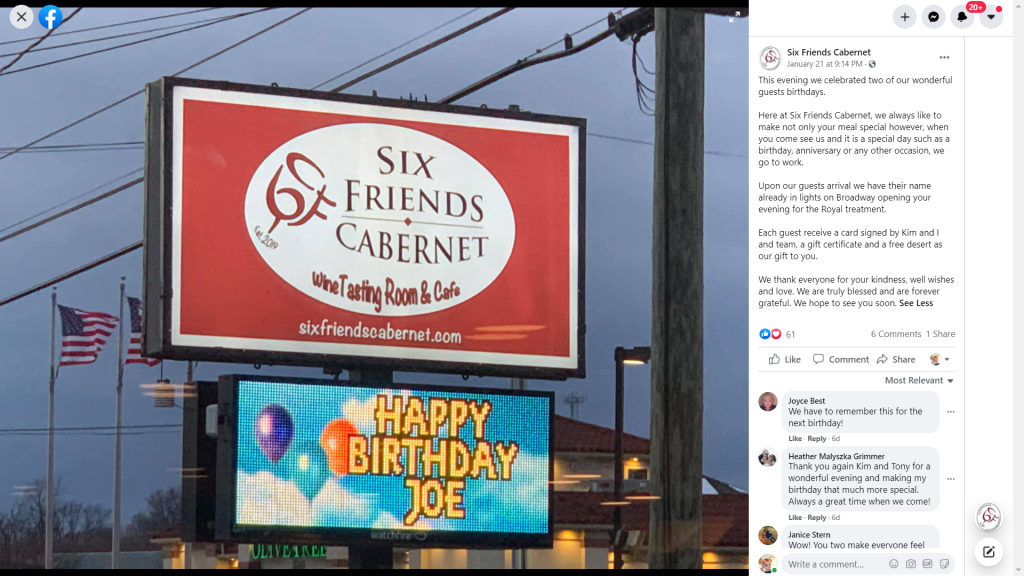For any business, grasping and keeping a good reputation is like caring for a fiddle leaf fig tree: It’s a lot of work, one wrong move can spell disaster and the situation can get out of control in a hurry; however, successful results can be staggering.
Customers develop a perception of a brand based on what they see and hear about that brand: in-person, in the media and on social media. Companies can largely manage and support their brand based on interactions with consumers, wherever those interactions might occur.
Here’s a few ideas for how to make – and keep – a good reputation for your business:
When starting out or rebooting your efforts, it’s best to select the communication platform you’re most comfortable using. Ideally, this platform should reach your target audience.
It is also important to know your customers, and what motivates their spending in your industry. Speak with customers directly, as well as your managers, salespeople, service professionals, servers and/or bartenders. Customers ought to be the core of your reputation management efforts, and learning about customers makes for a smarter strategy.
Also, you should be working to keep your brand visible and in a positive light, even though we’re in the midst of a global pandemic. Waiting out tough times will cause you to fall behind, especially to competitors who stay engaged. In fact, tough times can offer opportunities to deepen existing connections, leverage creativity and explore alternate business models.
Discount-based incentives
According to Will Albers, a locally-based senior director of data engineering for a national Canadian retailer, companies can go a long way to gaining and keeping a good reputation by giving consumers what they want – such as a small discount on their purchases.
“It’s amazing how people respond to a small increment of additional value,” he said. “I really think it’s an emotional response, some part of the experience of getting something. It’s like, ‘Cool, I got something I normally wouldn’t get!’”

Individualized messaging
Of course, massive discounts will do wonders for your brand, but not for your bottom line. Interestingly, individualized messaging is another way to give your customers something they crave.
“If you can have a message to your consumer, that they feel is directed towards them, that positive experience – that thing that kicks off in your brain that happens when you’re given something – occurs again,” he said. “They feel special. It’s that feeling that generates loyalty. It’s that feeling that brings customers to you versus your competition.”
Providing individualized messaging is a lot easier for small businesses, and that ease is something they should be leveraging over their bigger competition.
Erika Wragula, a Lancaster resident and mother of two young adult daughters, told us that personal, one-on-one attention at Six Friends Wine Cabinet, her local wine bar, is what keeps her coming back.
“It’s a tiny place, but the owner always comes to your table, always, and asks how things are,” she said. “We’re honest with him and say, if one wine isn’t our favorite, he’ll say, ‘Oh, well next time try this one,’ or something like that. Having that manager or owner come to you makes all the difference in the world.”
That kind of positive one-on-one attention doesn’t have to happen only in an in-person setting. Speaking directly to consumers in a way that resonates can happen online, and in unexpected ways.

Social media
On the social media profiles for Free Street Tavern, a corner bar on Niagara Street in Buffalo, owner Joshua White has frequently taken bold stands in support of causes he and his staff feel passionate about, such as LGBTQ+ rights and Black Lives Matter. White said supporting these causes is a way to provide an inclusive, positive experience for staff and customers alike, admitting that his approach might not work for every business.
“A shoe store wants many customers to come in, spend 15 minutes, buy a pair of shoes and then maybe come back in a few months,” he said. “In our industry, we have to be engaged with the customers for a long period of time. So, if we’re gonna sit with somebody for two hours, we don’t want to sit with some dickhead, ya know?
“If we let people know where we’re at, it keeps a certain crowd out. Those are the people who come in and we’re like, ‘Fuck when are they gonna leave?’ We just don’t want them in there to begin with. So, it’s easier, I think, to just let them know. We’re not gonna tolerate that stuff, no matter how much money you’re gonna spend. It’s not worth it.”
Negative Comments & Reviews
Dealing with negative comments
Of course, taking bold stands on social media can get your business dragged, and lead to an epic backfire. Businesses need to be wary of any negative sentiment, political or otherwise, that might be out there. They should be especially concerned with negative sentiment that affects customer behavior, but mostly goes unexpressed.
“I guess I try not to be too negative to a company’s face,” Wragula told us. “If I went to a restaurant and got a really bad meal or something, I might say, ‘I couldn’t eat this,’ but otherwise I just check the place off my list, not go back and maybe tell a friend not to go there.”
Fortunately (some might say), social media has given everyone a platform, and many people are more than happy to express positive or negative thoughts about a business. Albers said companies would be wise to pay attention.
“I don’t know how much time I would spend reading comments, but I’d look at post counts and I’d spend a little bit of money on social media analysis with any one of the providers in the Buffalo area that do it,” he recommended. “Don’t go crazy. There’s no need to go crazy. Just to know, ‘We’ve had X amount of posts in the last month and they appear to be mostly positive versus negative’ – could be really, really beneficial.”

Responding to negative comments and reviews
According to local entrepreneur Gabrielle Mattina, who owns the Gypsy Parlor on Grant Street in Buffalo, it is important to acknowledge and address all valid, constructive criticisms.
“You have to think of the times that you wrote a bad review about another business,” she said.. “Were you really upset? Did it financially affect you? Did it waste your time? A bad review could be because your business negatively impacted someone, and you better fix the problem because no one wants that negative energy out there. Now sometimes you’ll run into a Karen or someone who is complaining about nothing. Those people I ignore on the internet.”
A proven approach to addressing negativity is to take the conversation over to direct messaging or over the phone. Sometimes, people criticizing your business are only seeking attention, and by taking the conversation private, you can weed out those purely motivated by attention seeking.
The takeaway
There are countless ways to build and support a reputation, too many to cover in this post, but ultimately, building and maintaining a reputation comes down to putting in the resources.
Mattina maintains a strong voice on social media and her activity has dovetailed neatly with a loyal customer following. She told us that brand maintenance for an established company like hers is about avoiding complacency.
“There comes a point in every business where you are on autopilot,” she said. “You don’t have to put as much effort into pumping up your brand because the business is steady. The problem with complacency is there’s always someone who can do it better out there and will snatch your business up if you are slacking. Maintaining isn’t enough: You have to strive to thrive.
















